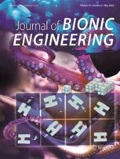Abstract
The study of bionics bridges the functions, biological structures and organizational principles found in nature with our modern technologies, and numerous mathematical and metaheuristic algorithms have been developed along with the knowledge transferring process from the lifeforms to the human technologies. Output of bionics study includes not only physical products, but also various computation methods that can be applied in different areas. People have learnt from biological systems and structures to design and develop a number of different kinds of optimisation algorithms that have been widely used in both theoretical study and practical applications. In this paper, a number of selected nature-inspired algorithms are systematically reviewed and analyzed. Though the paper is mainly focused on the original principle behind each of the algorithm, their applications are also discussed.
Similar content being viewed by others
References
Jackson D E, Ratnieks F L W. Communication in ants. Current Biology, 2006, 16, R570–R574.
Goss S, Aron S, Deneubourg J L, Pasteels J M. Self-organized shortcuts in the Argentine ant. Naturwissen-schaften, 1989, 76, 579–581.
Dorigo M. Optimization, learning and natural algorithms. Ph.D.Thesis, Politecnico di Milano, Italy, 1992. (In Italian)
Dorigo M, Gambardella L M. Ant colony system: A cooperative learning approach to the traveling salesman problem. IEEE Transactions on Evolutionary Computation, 1997, 1, 53–66.
Stützle T, Hoos H H. Max-Min ant system, future generation computer systems. Future Generation Computer Systems, 2000, 16, 889–914
Iredi S, Merkle D, Middendorf M. Bi-criterion optimization with multi colony ant algorithms, evolutionary multi-criterion optimization. First International Conference EMO 2001, Zurich, Switzerland, 2001, 359–372.
Beckers R, Deneubourg J L, Goss S. Trails and U-turns in the selection of the shortest path by the ant Lasius Niger. Journal of Theoretical Biology, 1992, 159, 397–415.
Martens D, Backer M De, Haesen R, Vanthienen J, Snoeck M, Baesens B. Classification with ant colony optimization. IEEE Transactions on Evolutionary Computation, 2007, 11, 651–665.
Baucer A, Bullnheimer B, Hartl R F, Strauss C. Minimizing total tardiness on a single machine using ant colony optimization. Central European Journal for Operations Research, 2000, 8, 125–141
Toth P, Vigo D. Models, relaxations and exact approaches for the capacitated vehicle routing problem. Discrete Applied Mathematics, 2002, 123, 487–512.
Secomandi N. Comparing neuro-dynamic programming algorithms for the vehicle routing problem with stochastic demands. Computers & Operations Research, 2000, 27, 1201–1225.
Aardal K I, van Hoesel S P M, Koster A M C A, Mannino C, Sassano A. Models and solution techniques for the frequency assignment problem. A Quarterly Journal of Operations Research, 2001, 1, 261–317.
Pham D T, Ghanbarzadeh A, Koc E, Otri S, Rahim S, Zaidi M. The Bees Algorithm, Technical Note, Manufacturing Engineering Centre, Cardiff University, UK, 2005.
Seeley T D. The Wisdom of the Hive: The Social Physiology of Honey Bee Colonies, Harvard University Press, Cambridge, 1996.
Frisch K V. Bees: Their Vision, Chemical Senses and Language, revised edition, Cornell University Press, Ithaca, New York, 1976.
Pham D T, Ghanbarzadeh A, Koç E, Otri S, Rahim S, Zaidi M. The bees algorithm — a novel tool for complex optimisation problems. Proceedings of 2nd International Virtual Conference on Innovative Production Machines and Systems, 2006, 454–461.
Pham D T, Ghanbarzadeh A, Koç E, Otri S. Application of the bees algorithm to the training of radial basis function networks for control chart pattern recognition. Proceeding of 5th CIRP International Seminar on Intelligent Computation in Manufacturing Engineering (CIRP ICME’06), Ischia, Italy, 2006, 454–461.
Olague G, Puente C. Honeybees as an intelligent based approach for 3D reconstruction. The 18th International Conference on Pattern Recognition, 2006, 1, 1116–1119.
Barricelli N A. Symbiogenetic evolution processes realized by artificial methods. Methods, 1957, 9, 143–182.
Fraser Alex, Burnell D. Computer Models in Genetics, McGraw-Hill, New York, 1970.
Cha S H, Tappert Charles C. A genetic algorithm for constructing compact binary decision trees. Journal of Pattern Recognition Research, 2009, 4, 1–13.
Ting C K. On the mean convergence time of multi-parent genetic algorithms without selection. Proceedings of the Eighth European Conference on Artificial Life, Canterbury, UK, 2005, 403–412.
Gondro C, Kinghorn B P. A simple genetic algorithm for multiple sequence alignment. Genetics and Molecular Research, 2007, 6, 964–982.
Hill T, Lundgren A, Fredriksson R, Schiöth H B. Genetic algorithm for large-scale maximum parsimony phylogenetic analysis of proteins. Biochimica Biophysica Acta, 2005, 1725, 19–29.
Li Y, Ang K H, Chong G C Y, Feng W, Tan K C, Kashiwagi H. CAutoCSD — Evolutionary search and optimisation enabled computer automated control system design. International Journal of Automation and Computing, 2004, 1, 76–88.
Ng K C. Switching Control Systems and Their Design Automation via Genetic Algorithms, PhD Thesis, University of Glasgow, 1995.
To C C, Vohradsky J. A parallel genetic algorithm for single class pattern classification and its application for gene expression profiling in Streptomyces coelicolor. BMC Genomics, 2007, 8, 6–9.
Wong K C, Leung K S, Wong M H. Effect of spatial locality on an evolutionary algorithm for multimodal optimization. Applications of Evolutionary Computation, 2010, 6024, 481–490.
Zhang J, Chung H S H, Lo W L. Pseudocoevolutionary genetic algorithms for power electronic circuits optimization. IEEE Transactions on Systems, Man, and Cybernetics, Part C: Applications and Reviews, 2006, 36, 590–598.
Willett P. Genetic algorithms in molecular recognition and design. Trends in Biotechnology, 1995, 13, 516–521.
Goldberg David E. Genetic Algorithms in Search Optimization and Machine Learning, Addison-Wesley Professional, 1st edition, 1989.
Vose M D, Wright A H, Rowe J E. Implicit parallelism. Proceedings of the Genetic and Evolutionary Computation Conference, 2003, 7–11.
Babu B G, Kannan M. Lightning bugs. Resonance, 2002, 7, 49–55.
Yang X S. Nature-Inspired Metaheuristic Algorithms. Luniver Press, Beckington, UK, 2008.
Yang X S. Firefly algorithms for multimodal optimization. Stochastic Algorithms: Foundations and Applications, 2009, 5792, 169–178.
Author information
Authors and Affiliations
Corresponding author
Rights and permissions
About this article
Cite this article
Zang, H., Zhang, S. & Hapeshi, K. A Review of Nature-Inspired Algorithms. J Bionic Eng 7 (Suppl 4), S232–S237 (2010). https://doi.org/10.1016/S1672-6529(09)60240-7
Published:
Issue Date:
DOI: https://doi.org/10.1016/S1672-6529(09)60240-7




